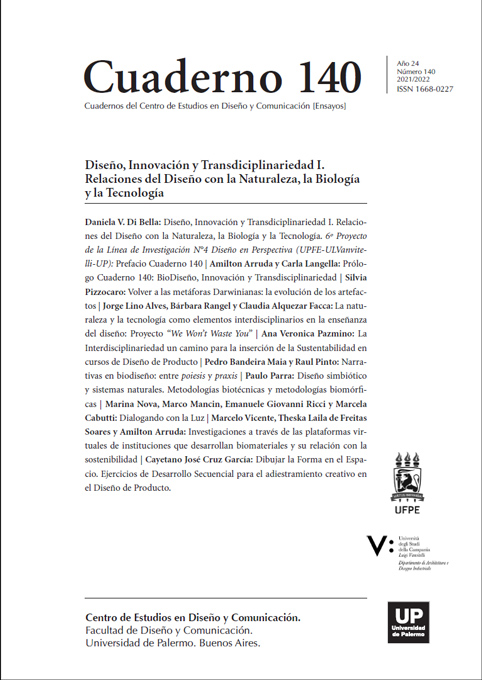Dibujar la Forma en el Espacio. Ejercicios de Desarrollo Secuencial para el adiestramiento creativo en el Diseño de Producto
Abstract
Training in the ideation of new objects requires the development of imagination. By means of a methodology based on drawing exercises of “sequential development”, like those initiated by J. Albers; a control of creative imagination is produced from an evolutionary process, open to decision making, and the relativity of Form and Space. The basic fundamentals of haptic perception allow to explain the proprioceptive condition of the object of representation; so that Form and Space are a consequence. A control of the ideation process is produced that allows to train and explain how things are and how they are born; helping to predict the behavior and possible needs in phases of a manufacturing process. Therefore, intuitive intelligence is fostered in the creative exercise, made available to the design process.
References
Cross, N. (1999). Natural intelligence in design. Design Studies, 20(1), 25-39.
Cruz, C. J. (2013). Idear la Forma: Capacitación creativa. Cuadernos del Centro de Estudios en Diseño y Comunicación. Ensayos, 43, 113-125.
Dantzic, C. M. (1999). How to draw. A complete guide to techniques and appreciation. London: Laurence King.
Dorst, K. & Cross, N. (2001). Creativity in the design process: co-evolution of problem-solution. Design Studies, 22(5), 425-437.
Goldschmidt, G. (1991). The dialectics of sketching. Creativity research journal, 4(2), 123- 143.
Jones, J. C. (1981). Design Methods, Wiley, Chichester.
Ham, D. A. (2016). How Designers Play: The Ludic Modalities of the Creative Process. Design Issues, 32(4), 16-28.
Lieberman, J. N. (2014). Playfulness: Its relationship to imagination and creativity. New York: Academic Press.
Mihaly, C. (1996). Creativity: Flow and the psychology of discovery and invention. Harper Perennial.
Norman, D. A. (1999). Affordance, conventions, and design. Interactions 6, 3, 38-43.
O’Reilly, C. J. (2016). Creative engineers: Is abductive reasoning encouraged enough in degree project work? Procedia CIRP, 50, 547-552.
Revest (1950) Psychology and art of the blind. London: Longmans Green&Co
Runco, M. A. (2003). Education for creative potential. Scandinavian Journal of Educational Research, 47(3), 317-324.
Runco, M. A., & Acar, S. (2012). Divergent thinking as an indicator of creative potential. Creativity research journal, 24(1), 66-75.
Los autores/as que publiquen en esta revista ceden los derechos de autor y de publicación a "Cuadernos del Centro de Estudios de Diseño y Comunicación", Aceptando el registro de su trabajo bajo una licencia de atribución de Creative Commons, que permite a terceros utilizar lo publicado siempre que de el crédito pertinente a los autores y a esta revista.


